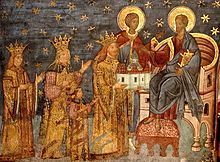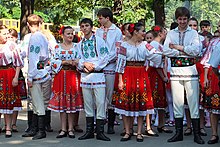Culture of Moldova
This article needs additional citations for verification. (July 2009) |


| Part of a series on the |
| Culture of Moldova |
|---|
 |
|
People |
|
Mythology |
| Festivals |
| Religion |
| Literature |
| Music |
| Sport |
The culture of .
During the centuries following the Roman withdrawal in 271, the population of the region was influenced by contact with the
The population of what once was the
The geographical area that is now modern Moldova was formed under the conditions of contacts with the East Slavic population, and later under the rule of the Ottoman Empire. In 1812, the territory of modern Moldova was liberated from Ottoman rule and incorporated into the Bessarabian province of the Russian Empire, which had a great influence on the development of the culture of the region. After the October Revolution in 1918, Romania annexed the nation for 22 years, and the Moldavian Autonomous Soviet Socialist Republic was formed on the left bank of the Dniester, as a result of which culture developed under a stronger Russian influence under Soviet administrative control, as well as by ethnic Russian or Russian-speaking immigration.
By 1918, Bessarabia was one of the least developed, and least educated European regions of the Russian Empire. In 1930, Moldova's literacy rate was 40%, while Romania itself had a 38% literacy rate according to the 1930 Romanian census. Especially low was the literacy rate for women, less than 10% in 1918, to just under 50% in 1940.[citation needed] Although Soviet authorities promoted education, the region's cultural ties with Romania were slowly eroded due to administrative policies. With many ethnic Romanian intellectuals, either fleeing, being killed after 1940, or being deported both during and after World War II, Bessarabia's cultural and educational situation changed drastically and became more Russified.
After the 1960s, Soviet authorities developed urban cultural and scientific institutions that were subsequently filled with Russians, and diverse ethnic groups from across the Soviet Union. Much of the urban culture came from Moscow, while the primarily rural ethnic Romanian population was allowed to express itself in folklore and folk art.
Folk culture


Although the
Moldova's traditional
Literary culture
The first books, religious texts, of the Principality of Moldavia appeared in the mid-17th century. Prominent figures in Moldavia's cultural development include
Varlaam published the first books. Dosoftei founded numerous schools and published a lot. Cantemir wrote the first thorough geographical, ethnographical, and economic description of Moldavia in Descriptio Moldaviae (Berlin, c. 1714).
Modern writers include
In the early 1990s, Moldova had twelve professional theaters. All performed in Romanian, except the A.P. Chekhov Russian Drama Theater in
Cuisine

Moldovan cuisine consists mainly of traditional European foods, such as beef, pork,
Very popular dishes include
Other common foods in Moldova include grilled meats, other grains,
).Sports
See also
References
- ^ Moldova's Culture
- ^ "Slavs in Moldova Bio". University of Maryland. Retrieved November 11, 2018.
- ^ Marcin Kosienkowski, "Polska a Mołdawia i Naddniestrze"
- ^ "Moldovan Culture and Traditions". Moldova Travel. Retrieved November 2, 2023.
External links
- Information about Moldova from the page of the Moldovan Ministry of Culture and Tourism (in English)
- www.moldova.md about Moldovan culture (in English)
- www.tur.md about Moldovan rest (in English)

